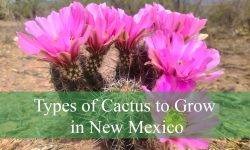Cultivating purple bulb flowers can add a touch of elegance to any garden. Several types stand out, each bringing its unique charm. The list includes the Grape Hyacinth (Muscari), which forms clusters resembling grapes, and the Purple Sensation Allium, known for its spherical, deep purple blooms. Additionally, the Fritillaria imperialis, or Crown Imperial, boasts striking, bell-shaped flowers in rich purples and maroons. Explore 18 different purple bulb flower species below that will offer a wonderful range of colors and forms for any gardening enthusiast.
Beautiful Types of Purple Bulb Flowers
1. Purple Sensation (Allium Hollandicum)
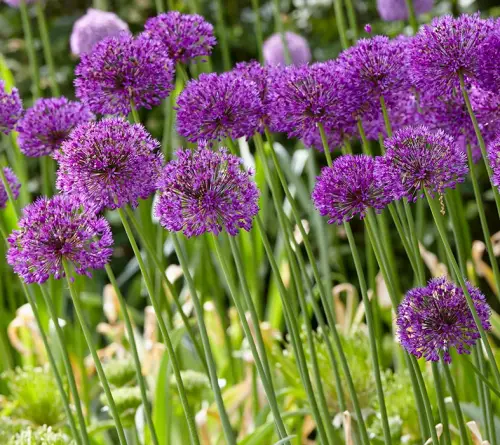
Purple Sensation (Allium Hollandicum) from the Amaryllidaceae family originates in central China and Iran. With a diverse array of flowers on leafless stems, it attracts butterflies and repels deer, rodents, and rabbits.
Thrives in summer and fall, reaching 2-6 inches, tolerating partial shade but preferring full sun for at least six hours daily. Adaptable to various soil types, it is drought-tolerant and propagated through bulb clump division in early spring or fall, with some cultivars producing small bulbils within their blossoms.
2. Blazing Star (Liatris Spicata)
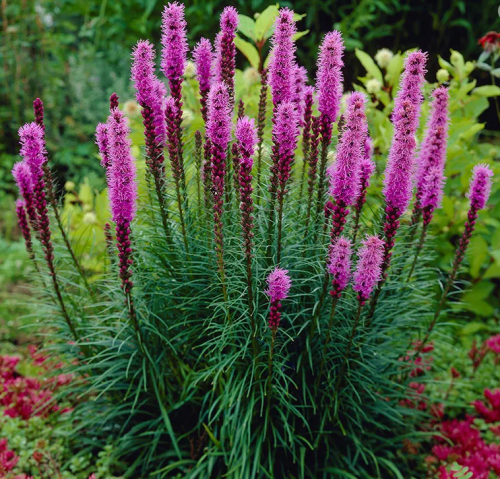
Belonging to the Asteraceae family, Blazing Star (Liatris Spicata) is a native perennial of eastern North America. Its narrow, grass-like leaves turn bronze in fall, complementing its top-down blooming stalks, alluring pollinators.
Thriving from summer to early fall, it stands 2-5 feet tall and spans 9-18 inches wide, suited for both indoor and outdoor settings. Thrives in full sun, nutrient-rich, slightly acidic soil, needing around 1 inch of water weekly during warmer months. Drought-tolerant after the first season, it propagates best through division in early spring.
3. Saffron Crocus
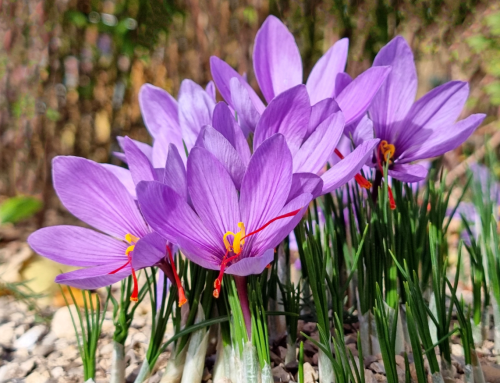
Saffron Crocus, or officially Crocus sativus, gets its name from the stamens of its bloom, which are the source of saffron, an expensive but useful spice. The distinctive purple blossoms, which contrast sharply with the reddish-orange stigmas, usually have six petals grouped in a cup-like arrangement. This type of crocus requires a period of cold hibernation throughout the winter to promote the development of flower buds.
The Purple crocus (Crocus tommasinianus) and Dutch crocus (Crocus vernus) are two other well-known members of the Crocus family.
4. Amethyst Meadow Squill
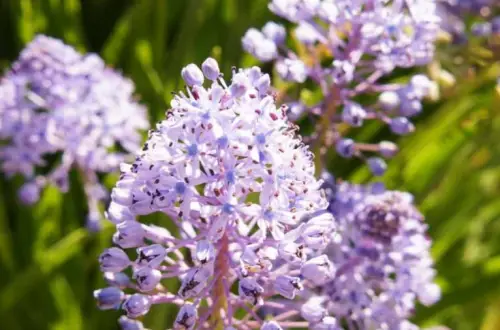
The purple bulbous perennial Amethyst Meadow Squill, scientifically known as Scilla litardierei, is so good that the Royal Horticultural Society awarded it the prestigious Award of Garden Merit. With clusters of pendulous blooms that usually have six violet or purple petals, the plant’s flower stalks gently emerge from the middle of the basal leaves. Its attractiveness in gardens is enhanced by the fascinating bell- or star-shaped beauty of the flowers.
5. Queen of Night Tulip
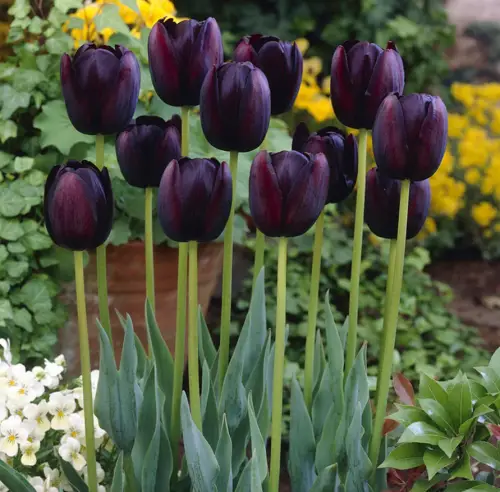
Known by the botanical name Tulipa ‘Queen of Night,’ this tulip variety commands attention with its striking deep, dark purple, almost black blooms. Classified as a single late tulip, it typically graces gardens towards the end of the tulip blooming season, usually in late spring. ‘Queen of Night’ tulips boast a classic cup-shaped structure with a luxurious velvety texture, garnering significant admiration for their dramatic and elegant presence.
Among the diverse range of tulip varieties, numerous options are available in the spectrum of purple, varying from rich violet tones to delicate lavender shades.
6. Ornamental Onion
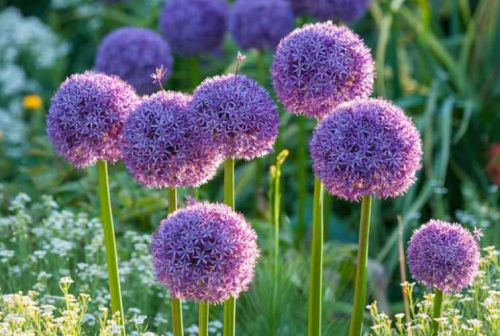
The Ornamental Onion, belonging to the Amaryllidaceae family, thrives in Wisconsin. Known for its clustered pom-pom-shaped flowers and fragrant garlic and onion-like leaves, it grows 1-4 feet tall and 3-10 inches wide in spring. Its vibrant blooms come in purple, pink, yellow, white, and green.
This plant prefers full sun but can endure partial shade, thriving in slightly acidic soil. Adequate drainage is ensured by adding organic matter. It requires moderate watering, supplemented by occasional watering every 3-5 days during dry spells. A light application of balanced fertilizer post-bloom rejuvenates plants in poor soils. Propagation is easily done by separating bulb offshoots.
7. Netted Iris (Iris Reticulata)
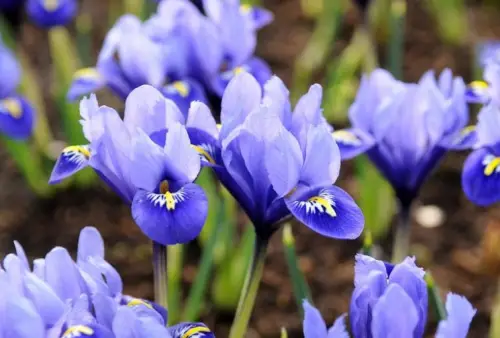
The Netted Iris (Iris Reticulata), native to Eastern Turkey to Iran, displays 2-3 inch-wide blooms with three sepals, petals, and stigma branches. Its fan-like leaves overlap at the base. With a modest height of 4-6 inches during spring, it’s a great indoor addition.
It thrives in well-drained, moist, gravelly soil, preferring full sunlight but tolerating partial shade. Adequate watering during blooming, avoiding it in summer, is crucial to prevent root issues. Fertilizers are unnecessary in nutrient-rich soil, while propagation is easily achieved through division.
8. Morning Glory
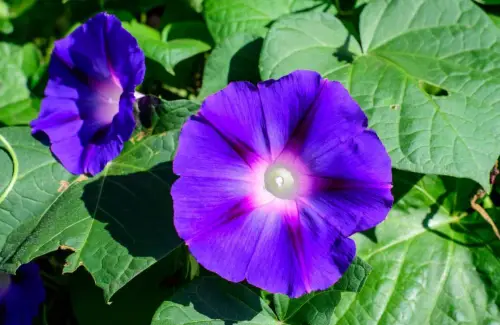
Morning Glory, from Central and Southern America, now thrives in North America. Its trumpet-shaped, 3-inch-wide flowers and heart-shaped leaves add ornamental value. Cultivate in summer and fall, reaching 6-10 feet in height and 3-6 feet in width.
Blooms persist by getting 6-8 hours of direct sunlight. It adapts to various environments, favoring moist, well-drained, slightly acidic soil with minimal organic content. Regular watering, about an inch per week, along with mulching, aids growth. Monthly low-nitrogen fertilizer supplements during the growing season. Propagate via seeds.
9. Dutch Hyacinth
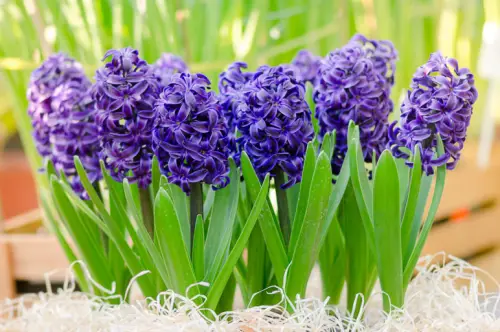
Enter the world of Dutch Hyacinth, officially identified as Hyacinthus orientalis ‘Miss Saigon,’ celebrated for its delightful, bell-shaped flowers that cluster together in dense spikes, known as racemes, elegantly rising above its strap-like leaves. Showcasing a rich, dark purple hue, the blossoms of ‘Miss Saigon’ emit a powerful fragrance, rendering it a favored option for infusing gardens and indoor settings with an enchanting and aromatic ambiance.
10. Grape Hyacinths
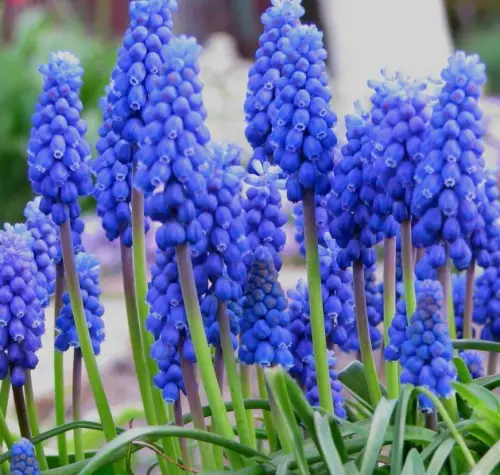
Scientifically known as Muscari spp., Grape Hyacinths are noted for their unusual bell-shaped flower clusters that resemble lovely bunches of grapes. These little bulbous plants, which are members of the Asparagaceae family, are charming additions to many types of settings. The flowers display a captivating range of purple tones, from deep blue-purple to delicate tints of lavender, depending on the cultivar. Because of their adaptability, they may be used in a variety of contexts, such as rock gardens, spring gardens, and as borders or edging plants, which guarantees that garden enthusiasts will continue to adore them.
11. Butterfly Bush (Buddleja Davidii)
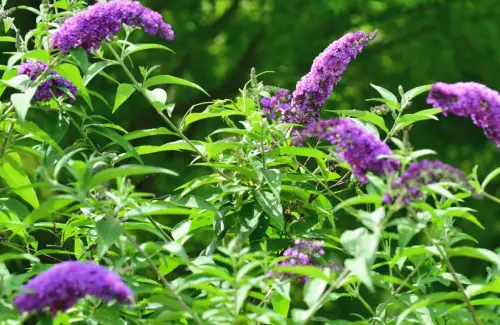
Butterfly Bush (Buddleja Davidii) hails from central China but thrives effortlessly in North America. Its arching branches bear stunning light purple flowers with an orange center in spring. Varieties abound for diverse garden choices.
Cultivate it via potted nursery starts or seeds in spring. Rapid growth yields a height of 3 to 12 feet and a width of 3 to 8 feet in a single season. It prefers six hours of full sun daily and adapts to somewhat well-drained, slightly acidic to neutral pH soil.
During active growth without rainfall, water the plant about one inch per week. While it doesn’t require fertilizer, a thin layer of compost in the root area every spring aids growth. Propagate through cuttings for ease.
12. Woodland Sage (Salvia nemorosa)
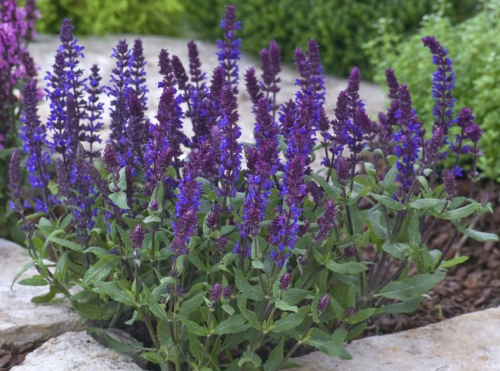
Woodland Sage (Salvia nemorosa), a medium-sized perennial, hails from Europe and Western Asia, drawing in hummingbirds, bees, and butterflies with its purple flowers and minty scent. It blooms from June to September, standing at three feet tall and two feet wide.
Requiring at least six hours of sunlight, it prefers shaded areas to prevent leaf scorching. Thriving in clay or rich soils, it doesn’t demand additional fertilization. Despite its drought tolerance, minimal watering suffices even during the dry summer. Propagation occurs through vegetative cuttings in spring or early summer, or via seeds at any time.
13. Pasque Flower (Pulsatilla Vulgaris)
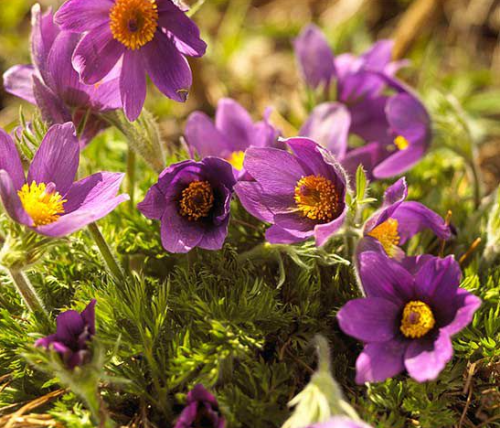
Pasque Flower (Pulsatilla Vulgaris), an early-blooming perennial, stands at 9 to 12 inches in height and width. With cream, purple, lavender, and white blooms, it thrives in well-drained, sandy soil under full sun but avoids full shade.
The plant enjoys regular watering, with two or three times per week at the base. While it tolerates drought, it requires minimal feeding, making it low-maintenance. Propagation methods include division, root cuttings, and seeds.
14. Gladiator Allium
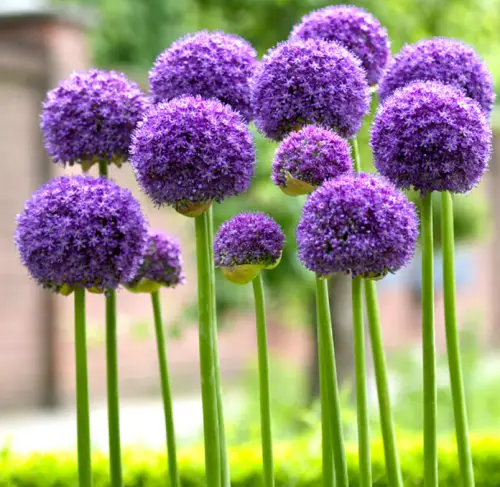
Gladiator Allium, known by its botanical name Allium giganteum, stands as a tall and majestic ornamental plant within the Amaryllidaceae family. Reaching impressive heights of 3-4 feet, it showcases a magnificent flower head that spans a diameter of 6-8 inches. Robust and upright, the flower stalks gracefully elevate the large spherical clusters of purple or violet blooms above the surrounding foliage, making for a stunning garden spectacle.
15. Lavender Gem Calla Lily
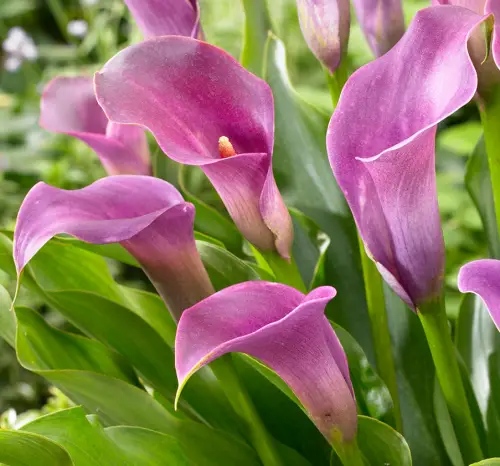
The Lavender Gem Calla Lily, scientifically known as Zantedeschia ‘Lavender Gem,’ showcases magnificent, trumpet-shaped flowers boasting a distinct lavender hue. These elegant blooms elegantly perch atop long, slender stems, encompassed by glossy heart-shaped leaves adorned with delightful white or silver markings. Renowned for their ease of cultivation, calla lilies serve as excellent choices for enhancing gardens, borders, or even potted displays, adding a touch of grace and sophistication to any setting.
16. Dahlia Blue Bell
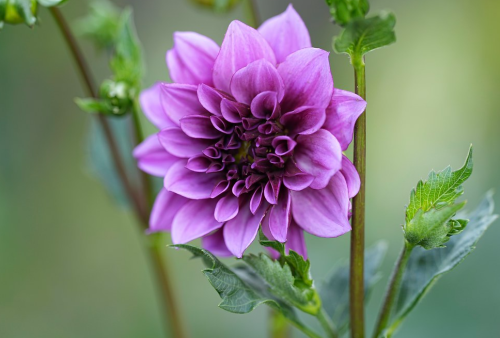
Meet the Dahlia Blue Bell, officially known as Dahlia ‘Blue Bell,’ boasting captivating purple-blue flowers that captivate both in the garden and as a stunning addition to any vase. These large, showy flowers flaunt layers upon layers of petals, resulting in a mesmerizing and enchanting display. With its distinct and alluring purple blossoms, the ‘Blue Bell’ dahlias effortlessly command attention, ensuring they become a captivating topic of discussion in any garden setting.
17. Dutch Iris
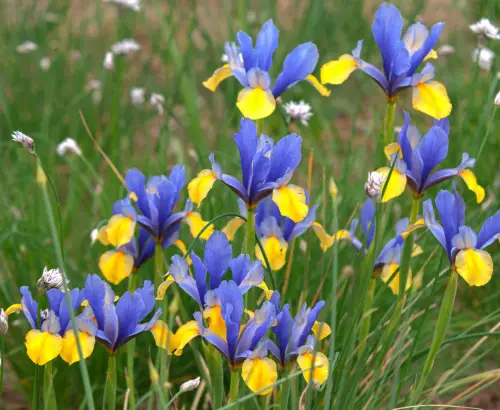
Let’s explore the Dutch Iris, scientifically labeled as Iris × Hollandica, renowned for its captivating spring blossoms that typically grace gardens in late spring or early summer. Showcasing a vibrant palette, these flowers emerge in an array of enchanting colors, including shades of blue, purple, white, and yellow. With their striking allure and extended lifespan in vases, they remain a sought-after choice for floral arrangements and cut flower displays.
Moreover, within the realm of iris bulb flowers, you’ll encounter other popular varieties such as the ‘Bearded’ iris (Iris germanica) and the ‘Siberian’ iris (Iris sibirica), both presenting captivating shades of purple.
18. Fritillarias
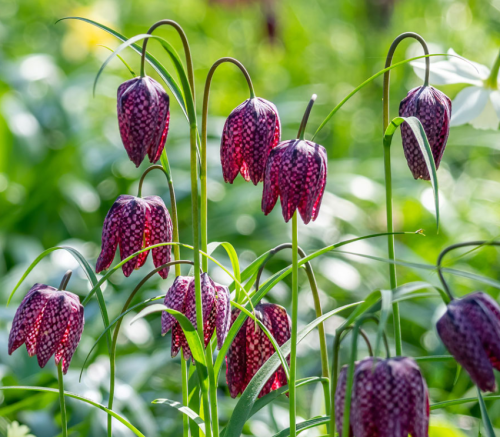
Explore the realm of Fritillarias, which are botanically referred to as Fritillaria spp., and witness their unique allure as bulb flowers that blossom into elegant, nodding, bell-shaped blooms. A royal touch can be added to any floral arrangement or garden setting by some species, such Fritillaria imperialis, also known as Crown Imperial, which has an enticing palette of purple colors, including rich maroon and deep purple.
People Who Read This Also Read:


